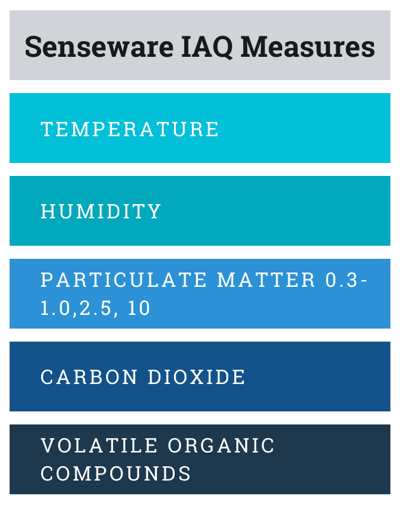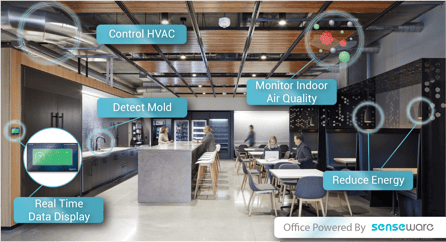Author: Julien Stamatakis Ph.D., Senseware CTO and Co-Founder
Indoor Air Quality scores seem to be popping up everywhere claiming to tell you if the air you're breathing is safe. But are these scores legitimate? How are they calculated? What factors do they take into consideration? We'll be diving into all this today.
Colors and 0-100 Point Rating System
Concerns about Indoor Air Quality (IAQ) have existed long before the onset of COVID-19. That the science has established that viruses spread mainly from person-to-person through respiratory droplets (bio-aerosols) produced when an infected person coughs, sneezes, or talks, has only increased the concern by the general public about what they may be breathing. It is hard to escape the fact that the primary top-of-mind issue today is what is in the air? Masks and vaccines reinforce those concerns daily.
The industry understands this base concern. They have sought to generate confidence in the quality of the air within the built environment by providing an assessment of the air itself. Real-time IAQ monitoring has advanced rapidly as visibility into the Internet of Things (IoT) has quickly advanced the state of the art. Real-time IAQ monitoring with public-facing cloud dashboards are now beginning to gain acceptance as a de facto type expectation being placed on building owners and operators. Having a clear view of the state of environmental conditions aligns with a key part of Environmental, Social, and Governance (ESG) reports that codify Health and Wellness programs for companies.
Notwithstanding these efforts, the search for an IAQ Index or AQI (air quality index) that provides an easily consumable rating of the quality of the air in a given space is desired. Who wouldn’t want a green, yellow, red indicator within a 0-100 point rating system that provides an IAQ Index score of air health?
This would be great . . . in theory . . . but likely misleading. Here are a few considerations that explore the topic.
Concentration and Contaminant Types are the Foundation of IAQ Analysis

The air includes far more than a single airborne pollutant. The most common IAQ monitoring systems include a discrete set of IAQ sensors (e.g., Temperature, Humidity, Carbon Dioxide (CO2), Particulate Matter (PM), and Total Volatile Organic Compounds (TVOCs).
In theory, one could develop a formula that factors in the relative weightings of the measurement data from the discrete set of IAQ sensors to produce an IAQ Index. Even if you could, the resulting IAQ Index would not factor in ALL possible pollutants that exist in the air.
Take for example the existence of bio-aerosols in the air, which may contain COVID-19. Bio-aerosol levels can be detected using a bio-aerosol sensor. A COVID-19 specific sensor even exists, which can detect COVID-19 specific bio-aerosol levels.
For a COVID-19 contaminant type, the key factor is the relevant concentration of that contaminant type. At high enough COVID-19 bio-aerosol levels, it could be said that an acute infection risk may exist at that higher viral load. The point here is that IAQ Indexes advertised in the marketplace do not account for all contaminants in the air such as COVID-19 bio-aerosol levels. Thus, the public can easily be misled with a purported IAQ Index that doesn’t actually account for COVID-19 bio-aerosols. The public would assume that an IAQ Index score in the “green” meant that COVID-19 bio-aerosols did not exist at levels presenting an infection risk, when that would actually be false.
IAQ Indexes Can Give a False Sense Of Security
IAQ Indexes have great value in communicating a general air health score without providing underlying IAQ data analytics. The problem, as illustrated above, is that IAQ Indexes can be relied upon for the general proposition that the air is “healthy” when no such claim can be or is intended to be made when considering ALL potential contaminant types in the air.
The potential misleading nature of an IAQ Index can be seen more clearly when you consider the scrutiny the IAQ Index would receive if it was actually making a health-related claim. Would it be subjected to scrutiny by peer-reviewed medical research? Would it potentially suffer from false advertising claims by a public that felt aggrieved that the purported IAQ claims were unsubstantiated? The last thing anyone would want would be to read disclaimers in the fine print regarding what the IAQ Index did or did not claim to represent.
In this context, it is easy to see that IAQ Indexes have great potential value but are fraught with potential pitfalls in their implementation. The fact that there is little consensus from the scientific community about what combination of factors is considered healthy versus unhealthy further complicates the issue.
For individual contaminant types, relative concentration levels for that particular contaminant type alone can be found, which indicates whether a healthy or unhealthy condition exists. For example, much literature can be found about carbon dioxide (CO2) levels that potentially impede cognitive function. Extending to a broad set of air contaminants is a vastly different scientific enterprise. It is an open question as to whether a true IAQ Index is viable pending further research.
Where to go From Here?

IAQ Indexes have great potential value should the particular goals of a given IAQ application be defined. It is much easier to define an IAQ Index that represents a custom analytic used to adjust some parameter of facility operation. For example, does the analytic enable an assessment of ventilation performance? Does the analytic enable an assessment of air filtration performance? Does the analysis enable an assessment of NeedlePoint Bipolar Ionization (NPBI) efficacy?
All of these IAQ analytics have great utility, and need not rise to a claim regarding the “health” of the air. Why? Because the IAQ analytic is to be used by Subject Matter Experts (SMEs) who understand what is included in the IAQ analytic and what the relative levels mean for their given IAQ application. In that context, the custom IAQ analytic could appropriately be used as an IAQ Index by the SMEs. This situation is far different from a general public that is not knowledgeable of the underlying IAQ Index calculation nor what the resulting “score” means. The general public relies on the experts for claims regarding air “health” and the potential to mislead becomes far too great.
IAQ Indexes can form the foundation of useful analytics having great utility. Whether an absolute IAQ Index can be produced is debatable at this time. What may prove more profitable is having an IAQ Index that can be used to compare relative performance between buildings and spaces. Such an endeavor would be beneficial in enabling a discovery of relative “health” between buildings and spaces.
Does Senseware have an air quality score?
You may have guessed that Senseware does not have a generic air quality score. Instead, we use our robust analytics platform to generate a ventilation performance score that tells you how well your space is ventilated using variations in different contaminants as a proxy for ventilation. Good ventilation is an important factor in having clean air. For our enterprise customers, we develop a score that is unique to them and their space. It’s a propriety approach and takes into consideration the purpose of the space, occupancy, geography, and a number of other factors. Learn more by booking a demo below.
Are you already a Senseware customer? If you would like to purchase an IAQ solution for your building, shoot us a note at sales@senseware.co

